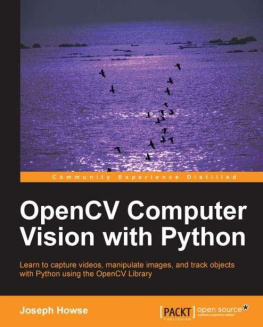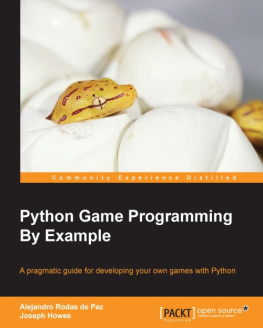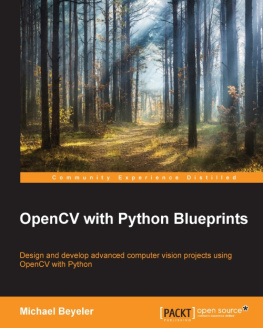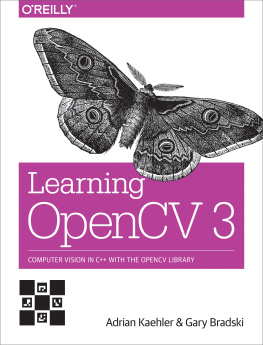Joseph Howse - Learning OpenCV 5 Computer Vision with Python - Fourth Edition
Here you can read online Joseph Howse - Learning OpenCV 5 Computer Vision with Python - Fourth Edition full text of the book (entire story) in english for free. Download pdf and epub, get meaning, cover and reviews about this ebook. year: 2023, publisher: Packt Publishing, genre: Romance novel. Description of the work, (preface) as well as reviews are available. Best literature library LitArk.com created for fans of good reading and offers a wide selection of genres:
Romance novel
Science fiction
Adventure
Detective
Science
History
Home and family
Prose
Art
Politics
Computer
Non-fiction
Religion
Business
Children
Humor
Choose a favorite category and find really read worthwhile books. Enjoy immersion in the world of imagination, feel the emotions of the characters or learn something new for yourself, make an fascinating discovery.
- Book:Learning OpenCV 5 Computer Vision with Python - Fourth Edition
- Author:
- Publisher:Packt Publishing
- Genre:
- Year:2023
- Rating:3 / 5
- Favourites:Add to favourites
- Your mark:
- 60
- 1
- 2
- 3
- 4
- 5
Learning OpenCV 5 Computer Vision with Python - Fourth Edition: summary, description and annotation
We offer to read an annotation, description, summary or preface (depends on what the author of the book "Learning OpenCV 5 Computer Vision with Python - Fourth Edition" wrote himself). If you haven't found the necessary information about the book — write in the comments, we will try to find it.
Learning OpenCV 5 Computer Vision with Python - Fourth Edition — read online for free the complete book (whole text) full work
Below is the text of the book, divided by pages. System saving the place of the last page read, allows you to conveniently read the book "Learning OpenCV 5 Computer Vision with Python - Fourth Edition" online for free, without having to search again every time where you left off. Put a bookmark, and you can go to the page where you finished reading at any time.
Font size:
Interval:
Bookmark:

Copyright 2022 Packt Publishing
All rights reserved. No part of this book may be reproduced, stored in a retrieval system, or transmitted in any form or by any means, without the prior written permission of the publisher, except in the case of brief quotations embedded in critical articles or reviews.
Every effort has been made in the preparation of this book to ensure the accuracy of the information presented. However, the information contained in this book is sold without warranty, either express or implied. Neither the author, nor Packt Publishing, and its dealers and distributors will be held liable for any damages caused or alleged to be caused directly or indirectly by this book.
Packt Publishing has endeavored to provide trademark information about all of the companies and products mentioned in this book by the appropriate use of capitals. However, Packt Publishing cannot guarantee the accuracy of this information.
Early Access Publication: Learning OpenCV 5 Computer Vision with Python
Early Access Production Reference: B18454
Published by Packt Publishing Ltd.
Livery Place
35 Livery Street
Birmingham
B3 2PB, UK
ISBN: 978-1-80323-022-1
www.packt.comWelcome to Packt Early Access. Were giving you an exclusive preview of this book before it goes on sale. It can take many months to write a book, but our authors have cutting-edge information to share with you today. Early Access gives you an insight into the latest developments by making chapter drafts available. The chapters may be a little rough around the edges right now, but our authors will update them over time. You can dip in and out ofthis bookorfollow alongfrom start to finish; Early Access is designed to be flexible. We hope you enjoy getting to know more about the process of writing a Packt book.
- Chapter 1: Setting Up OpenCV
- Chapter 2: Handling Files, Cameras, and GUIs
- Chapter 3: Processing Images with OpenCV
- Chapter 4: Depth Estimation and Segmentation
- Chapter 5: Detecting and Recognizing Faces
- Chapter 6: Retrieving Images and Searching Using Image Descriptors
- Chapter 7: Building Custom Object Detector
- Chapter 8: Tracking Objects
- Chapter 9: Camera Models and Augmented Reality
- Chapter 10: 3D Reconstruction and Navigation
- Chapter 11: NeuraNetworks with OpenCV - an Introduction
- Chapter 12: OpenCV Applications at Scale
Computer vision makes many futuristic-sounding tasks a reality. Two such tasks are face detection (locating faces in an image) and face recognition (identifying a face as belonging to a specific person). OpenCV implements several algorithms for face detection and recognition. These have applications in all sorts of real-world contexts, from security to entertainment.This chapter introduces some of OpenCV's face detection and recognition functionality, along with data files that define particular types of trackable objects. Specifically, in this chapter, well look at Haar cascade classifiers, which analyze the contrast between adjacent image regions to determine whether or not a given image or sub-image matches a known type. We consider how to combine multiple Haar cascade classifiers in a hierarchy so that one classifier identifies a parent region (for our purposes, a face) and other classifiers identify child regions (such as eyes).We also take a detour into the humble but important subject of rectangles. By drawing, copying, and resizing rectangular image regions, we can perform simple manipulations on image regions that we are tracking.We will cover the following topics:
- Understanding Haar cascades
- Finding the pre-trained Haar cascades that come with OpenCV. These include several face detectors
- Using Haar cascades to detect faces in still images and videos
- Gathering images to train and test a face recognizer
- Using several different face recognition algorithms: Eigenfaces, Fisherfaces, and Local Binary Pattern Histograms (LBPHs)
- Copying rectangular regions from one image to another, with or without a mask
- Using a depth camera to distinguish between a face and the background based on depth
- Swapping two people's faces in an interactive application
While this chapter focuses on classic approaches to face detection and recognition, we will go on to explore advanced new models by using OpenCV with a variety of other libraries in Chapter 11, Neutral Networks with OpenCV an Introduction.
By the end of this chapter, we will have integrated face tracking and rectangle manipulations into Cameo, the interactive application that we have developed in previous chapters. Finally, we will have some face-to-face interaction!
This chapter uses Python, OpenCV, and NumPy. As part of OpenCV, it uses the optional opencv_contrib modules, which include functionality for face recognition. Some parts of this chapter use OpenCV's optional support for OpenNI 2 to capture images from depth cameras. Please refer back to Chapter 1, Setting Up OpenCV, for installation instructions.The complete code for this chapter can be found in this book's GitHub repository, https://github.com/PacktPublishing/Learning-OpenCV-5-Computer-Vision-with-Python-Fourth-Edition, in the chapter05 folder. Sample images are in the repository images folder.A subset of the chapters sample code can be edited and run interactively in Google Colab at https://colab.research.google.com/github/PacktPublishing/Learning-OpenCV-5-Computer-Vision-with-Python-Fourth-Edition/blob/main/chapter05/chapter05.ipynb.
When we talk about classifying objects and tracking their location, what exactly are we hoping to pinpoint? What constitutes a recognizable part of an object?Photographic images, even from a webcam, may contain a lot of detail for our (human) viewing pleasure. However, image detail tends to be unstable with respect to variations in lighting, viewing angle, viewing distance, camera shake, and digital noise. Moreover, even real differences in physical detail might not interest us for classification. Joseph Howse, one of this book's authors, was taught in school that no two snowflakes look alike under a microscope. Fortunately, as a Canadian child, he had already learned how to recognize snowflakes without a microscope, as the similarities are more obvious in bulk.Hence, having some means of abstracting image detail is useful in producing stable classification and tracking results. The abstractions are called features, which are said to be extracted from the image data. There should be far fewer features than pixels, though any pixel might influence multiple features. A set of features is represented as a vector (conceptually, a set of coordinates in a multidimensional space), and the level of similarity between two images can be evaluated based on some measure of the distance between the images' corresponding feature vectors.
Later, in Chapter 6, Retrieving Images and Searching Using Image Descriptors
Font size:
Interval:
Bookmark:
Similar books «Learning OpenCV 5 Computer Vision with Python - Fourth Edition»
Look at similar books to Learning OpenCV 5 Computer Vision with Python - Fourth Edition. We have selected literature similar in name and meaning in the hope of providing readers with more options to find new, interesting, not yet read works.
Discussion, reviews of the book Learning OpenCV 5 Computer Vision with Python - Fourth Edition and just readers' own opinions. Leave your comments, write what you think about the work, its meaning or the main characters. Specify what exactly you liked and what you didn't like, and why you think so.










